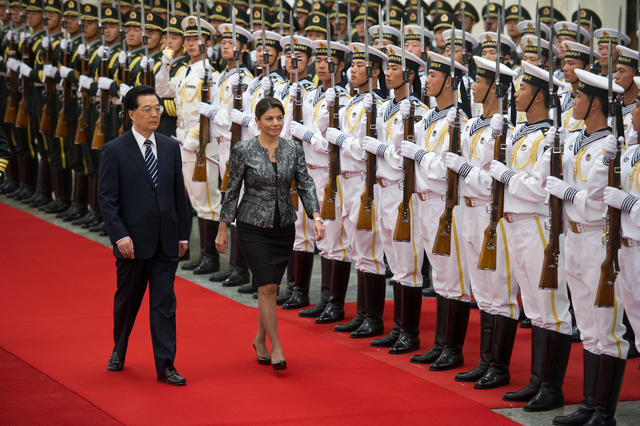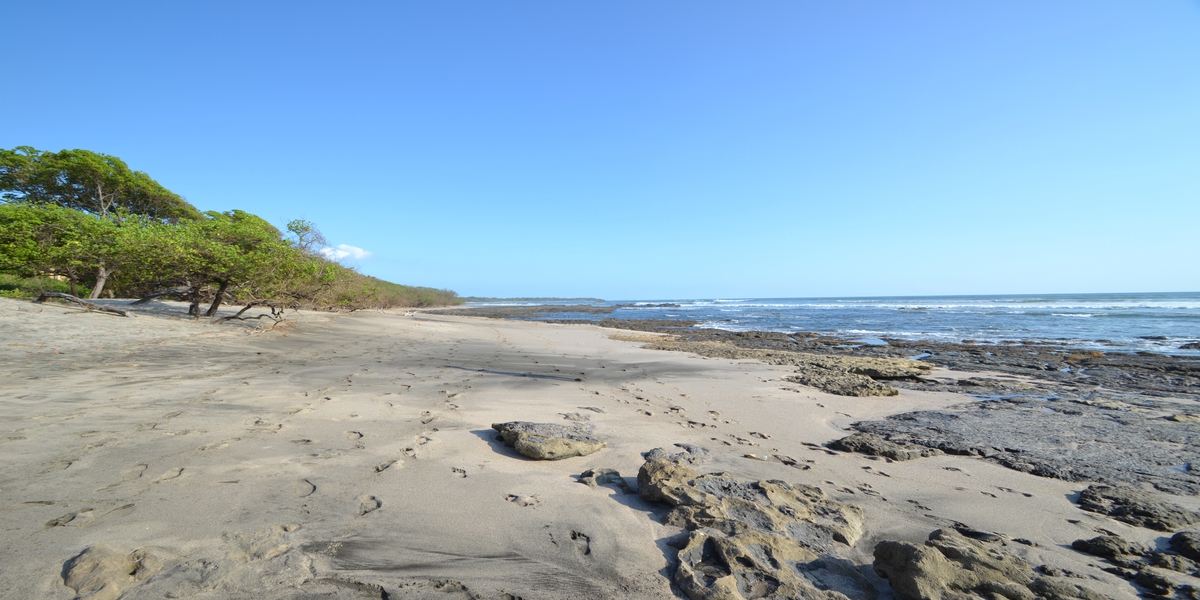China gives Costa Rica $25 million for police academy, 4,800 computers for schools and teachers, and another $8 million for the Costa Rican government to use at its discretion.
 At 5 p.m. in Beijing on Thursday, August 16, 2012, Costa Rican President Laura Chinchilla shook hands and posed for photos with China's leader Hu Jintao. Afterwards, the President Chinchilla and the Costa Rican delegation enjoyed a dinner in their honor.
At 5 p.m. in Beijing on Thursday, August 16, 2012, Costa Rican President Laura Chinchilla shook hands and posed for photos with China's leader Hu Jintao. Afterwards, the President Chinchilla and the Costa Rican delegation enjoyed a dinner in their honor.
This will be Costa Rica’s second official visit to China. President Chinchilla has been on a mission to demonstrate to the Chinese how serious Costa Rica takes its burgeoning relationship with the Asian power.
A week into her trip, Chinchilla can claim several major investments. After the meeting with Chinese president, the countries finalized accords on the topics of education, business, security, agriculture, aviation and infrastructure. China agreed to build a $25 million police academy for Costa Rica and donate 4,800 computers for students and teachers. The Chinese government also gifted $8 million for Costa Rica to use at its own discretion.
The leaders also discussed building a large industrial park inside a Costa Rican free zone, a move that would put more investment dollars into the Central American country and give China a hub in the region for producing and selling its products.
Costa Rica remains the only country in Central America to establish diplomatic ties with China, after former President Oscar Arias severed diplomatic relations with Taiwan in 2007. Arias traveled to China in 2010. Two years later, Chinchilla’s eight-day tour serves to bolster those ties.
Costa Rica is looking to become a model for Chinese companies that export to developing nations. “We believe that Costa Rica has the best conditions to become the main logistics platform site for Chinese investment in the Western Hemisphere,” Chinchilla said at the end of a business and investment forum in Beijing earlier in the week. To achieve this, the Costa Rican government plans to build a tax-free industrial park for Chinese firms, which could guarantee them commercial advantages in developing markets, thanks to a network of trade agreements signed by the Central American country.
“It would be very difficult to say how many years it will take, but we want, as soon as possible, to begin feasibility studies and design proposals,” Chinchilla said.
Costa Rica, the third country in Latin America to sign a free trade agreement with China, has found benefits from the deal elusive. But the industrial park could be a solution for how both sides could profit from the pact. One of the models studied by the Costa Rican delegation during the visit was at the Suzhou Industrial Park. The business center was established in 1994 through a joint effort between the governments of China and Singapore, and the park houses more than 4,000 foreign enterprises.
Special Economic Zones have been an integral part of China’s economic model to maintain high growth rates in recent decades, and Chinchilla highlighted her government’s interest in replicating the model.
With the construction of the industrial park, Costa Rica would further enhance its own system of free zones, which process 50 percent of Costa Rican exports. “The model of free zones has been quite successful in terms of exports, job creation and technology transfer, but we view further innovation as essential for growth. We want to promote a greater linkage between industrial parks and the academic sector,” Costa Rican Foreign Trade Minister Anabel González said.
The Suzhou complex, said the minister, includes 23 research and development centers for industrial production. Traditionally, businesses from China have been reluctant to settle in foreign countries if they cannot hire Chinese labor, but the Chinchilla government seeks to take advantage of Beijing’s latest five-year plan to internationalize their countries.
“China is encouraging its companies to go abroad, while Costa Rica has free trade agreements with Canada, United States, Europe and several Latin American countries. As Chinese companies set up their production facilities [in Costa Rica], the two countries will benefit,” said Chai Yu, of the Chinese Academy of Social Sciences, who will lead a mission of professors and businesses to San José in September.
Promoting Chinese investment in Costa Rica also makes sense after China this week named the Central American country the host of a China Business Summit in Latin America in 2014.
On the issue of security, China agreed to fund the construction of a National Police Academy in Costa Rica for an estimated $25 million.
The academy will be located in the Caribbean canton of Pococí, and investment could reach $25 million. The donation is similar to the construction of Costa Rica’s National Stadium – a $100 million gift from China – in which a Chinese company will build the facility, and once completed, it will be officially donated to the Public Security Ministry. On the second day of her Asia tour, Chinchilla expressed her gratitude to China, saying the construction “is something we’ve long waited for.”
The Costa Rican government also continues to negotiate investment terms with China’s oil industry for a much-needed refinery upgrade. At start of the trip, representatives from the Costa Rican company GreenerSys signed an agreement with Chinese company GeSolar to build a solar power plant.
Chinchilla said on Monday she was pleased with the negotiations. “This is an excellent example of how we can unite the strengths of both countries to develop projects of mutual benefit,” she said.
The president and her entourage also spoke at a forum on trade, investment and tourism in Costa Rica, organized by the China Council for the Promotion of International Trade and Costa Rican officials.
The meeting with Jintao marked the conclusion of the most strenuous part of Chinchilla’s journey to China. The load lightens from here on out and includes a stop at one of the country’s most famous tourist attractions. On Friday, Chinchilla meets with Prime Minister Wen Jiabao, Vice President Xi Jinping and Wu Bangguo, head of China’s legislature.
On Saturday, the Costa Rican entourage will head to Xi’an to see the famous Terra Cotta Army, the collection of terra cotta statues that date back 2,200 years to the first Qin Dynasty. The next day, Chinchilla leaves to Seoul for a two-day tour of South Korea, also focused on promoting investment.
The Costa Rican delegation will return home next week.
Article Courtesy of the TICO TIMES, August 17, 2012
Matt Levin and Laianer Arias for The Tico Times & Andrés Bermúdez of AFP






